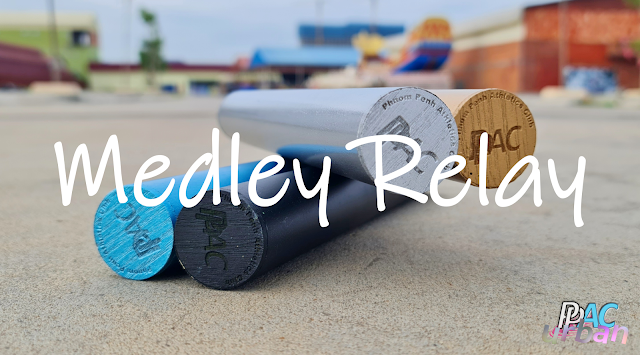For PPAC's 4th urban relay race the format was modified to a medley relay and two teams of four athletes took part in our first event of its kind.
In
three consecutive rounds, four team members must run legs of varying
distances (1
lap, 2 laps or 3 laps),
including two
team
laps where all but one of the team must run together. Before
the start of the race teams must choose the best strategy for the
order the athletes will
run
their legs. The
athletes must
all run one leg every round and
cannot
run the same distance in the first and second rounds. The
team order is submitted to the race officials before the start of the
race and
must be adhered to.
A
key idea behind the medley relay is to enable teams composed
of
runners across a range of running abilities, as well as mixed F/M
teams, to race together while maintaining a competitive and exciting
racing scenario. With
many possible permutations of leg order, a
team that may
look
slightly less strong on paper can exploit a superior strategy giving
itself a better opportunity to win.
One
lap of our course measures 275 m and both teams will complete 23 laps
for a total of 6.325
km, with individual
athletes running a
minimum of 5 laps (1.38 km) and maximum of 10 laps (2.75 km).
The team whose runner
crosses the line first on the final lap is the winner.
Team A carrying the blue baton was composed of Andarge, Jack, Meyjou and Matt, and Team B carrying the gold baton was composed of Neil, Leonardo, Muyngim and Hugo.
Team B led the race from the first lap with Hugo posting the fastest lap of the race in just 42.10 seconds (a full 4.5 s quicker than Matt's 2nd fastest lap overall, posted in the same leg). Team B held the lead at the end of 20 of the 23 laps during the race, establishing the biggest advantage of 13.8 seconds by the end of Leg 3 of Round 1.
However, Team A was able to stay in touch and as the team strategies unfolded parity was achieved at the end of Leg 2 of Round 2. Team B regained a useful lead for several laps but were pulled back again and Team A momentarily took the lead after Leg 1 of Round 2.
Despite a strong effort from Team B in the middle of Round 3, Team A's final two legs featuring Andarge and Matt were fast and perfectly executed, overturning an 8.4 s deficit from the end of Leg 2 and a penultimate leg deficit of 5.2 s to win the first PPAC Medley Race in 20:51, snatching a closely fought victory over +6 km of racing by just 2.3 s!
The table below shows a summary of performance for each individual athlete taking part in the relay race. Total distance run includes team laps, however, pace, leg and lap time analyses are made using only the solo lap data. The rest time calculations include the team laps run by the athlete.
The following chart shows every lap time by round (smallest bubble is Round 1, mid-sized bubble is Round 2, largest bubble is Round 3). If runners get more fatigued as the race progresses, and the shortest legs are the fastest, we might expect to see the smallest bubbles near the bottom (faster lap times in the earliest rounds) and to the left and right of the chart area (Legs 1, 4 and 5 being single lap legs). However, variation among the team's members and the related choice of optimal team strategy means the overall trends may not be so clear to see.
Every individual lap is displayed in the chart and table below, ordered from the fastest first. The size of the bubbles are proportional to the progression of each individual athlete's race in terms of total number of laps run. A small bubble indicates an early lap and the bigger bubbles indicate later laps (team laps are considered in the total number of laps an athlete has run, but the times are not included here). The colours indicate the leg and the specific lap of that leg. In the table individual lap times are compared with the equivalent 200 m pace.
Thanks to race officials Seavmey and Seavleang for overseeing the race, thanks to the PPAC team for putting together the latest medley relay race format and special thanks to Jack for handing us an awesome new set of PPAC relay batons (featured heavily in this blog!). Hope to see you all soon at the next event!
© PPAC 2021















Comments
Post a Comment